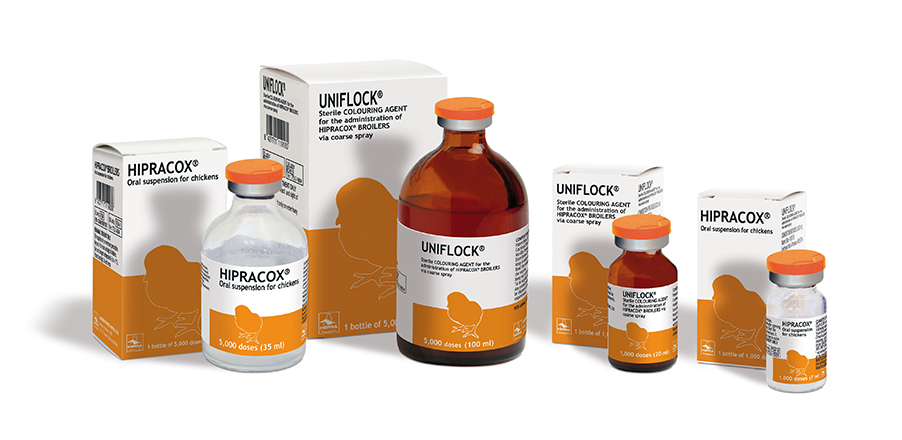Coccidiosis is one of the diseases with the greatest economic impact on modern poultry farming, causing millionaire losses globally every year. Because of its impact, control strategies are at the forefront of the health programme of poultry producers. In long life-living birds, the use of vaccines against the different species of Eimeria spp. is the most widespread option.
It is especially important to point out that with the vaccines that are available on the market, a distinction can be made between non-attenuated ones (wild strains of Eimeria spp.) and attenuated ones (strains of Eimeria spp. that are modified to reduce their virulence). In an article published in 2017 by Dardi et al., the use of live vaccines attenuated for precociousness against avian coccidiosis was proposed as a safe method of developing the immunity of long life-living birds, thereby preventing the disease and its harmful effects.
Materials and methods
The study was carried out on a poultry farm in Mexico located in a geographical area with average annual temperatures of 25oC and relative humidity of between 65 and 85%. This area, and more specifically this farm, have been considered historically by clinical veterinarians to be at high risk of outbreaks of avian coccidiosis.
30,000 broiler breeder chicks were vaccinated against avian coccidiosis by coarse spray on the first day of life with a live vaccine attenuated for precociousness. A protocol was implemented to monitor the development of immunity, which consisted of weekly collection of faecal samples to carry out a count of the oocysts per gram (OPG) between days 14 and 35 of life. Necropsies were carried out to quantify the intestinal lesions caused by coccidiosis (using the Johnson & Reid scale, 1970) on the days with the highest replication of the parasite (days 21, 28 and 35 days of life) and at the time which historically had been critical for outbreaks of Eimeria necatrix (56 days of life). The productive parameters of the birds were recorded weekly throughout the rearing period (20 weeks). At the same time, these results were compared with another flock from the same farm, under the same management during rearing, with the only difference being that they had received a vaccine against coccidiosis with non-attenuated strains.
Results and conclusions
When the dynamics of Eimeria spp. oocyst excretion in the group vaccinated with an attenuated vaccine were evaluated, significant replication of the vaccinal oocysts was observed, with a good level of excretion (over 13,000 oocysts/gram) at 21 days (Graph 1). It should be pointed out that at both 14 days and 21 days, the oocyst replication that occurred was of oocysts of vaccinal origin. This is because the strains are genetically precocious and, therefore, they replicate more quickly than field strains.
Another point to be highlighted regarding the oocyst excretion results was the replication peak. This occurred at 28 days, and was very high (over 100,000 oocysts/gram). These levels confirm that the farm was suffering a major coccidia challenge, as it is at this age that the exacerbated development of oocysts of field strains present on the farm typically occurs. Early replication of the vaccinal oocysts prevented the replication peak being even higher, which would have meant clinical problems in the birds and corresponding productive losses. On the other hand, the decrease in the oocyst count per gram at 35 days indicates that the birds were immunised from this time onwards.
At the same time, the results obtained in the assessment of intestinal lesions were 0 (according to the Johnson & Reid scale), for all the Eimeria species present in the vaccine attenuated for precociousness. Despite the resultant high oocyst counts in the faecal samples, no lesions were observed in the different portions of the intestine and caeca; this is because of the use of attenuated strains, together with early immunisation of the birds before the field challenge which occurred at 28 days of age. A good onset of immunity can also be inferred, as at about 8 weeks, which is the critical age in outbreaks of Eimeria necatrix, there was no damage to the intestinal mucosa consistent with this species.
One of the production variables that is most affected when there are coccidiosis problems (both clinical and subclinical) is mortality of the birds at an early age. In this study, the birds immunised with strains attenuated for precociousness had 2.64% and 4.11% lower mortality in females and males respectively (Graphs 3 and 4) compared to the group vaccinated with a non-attenuated vaccine.
The body weights of females and males were not affected by the administration of the vaccine attenuated for precociousness. The body weight of the females vaccinated with the vaccine attenuated for precociousness was 10 grams above the standard weight. In the case of the males, both those vaccinated with strains attenuated for precociousness, and those vaccinated with non-attenuated strains, their weight at 20 weeks of age was slightly above the parameter recommended for the breed.
Selection pressure, to obtain greater uniformity, was lower in the females and males that were vaccinated with the vaccine attenuated for precociousness (Graphs 7 and 8), thus reducing handling and stress of the birds (which can be immunosuppressive factors).
The uniformity of the flock was greater at the critical ages for coccidia challenges (between 8 and 12 weeks) in the group of birds immunised with the live vaccine attenuated for precociousness (Graph 9). Furthermore, the birds vaccinated with strains attenuated for precociousness did not receive anticoccidial treatments at any time, achieving good intestinal integrity, appropriate weight gain and less need for selection.
In conclusion, the results obtained in this study not only showed the efficacy of the use of live vaccines attenuated for precociousness in the prevention of coccidiosis in broiler breeders facing a challenge in geographical areas and farms at risk of outbreaks of coccidiosis, but also an improvement in productive indices compared to the use of non-attenuated vaccines.


